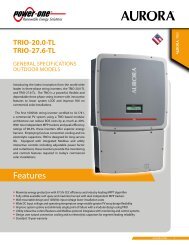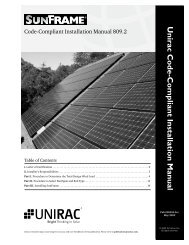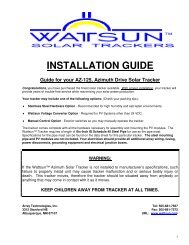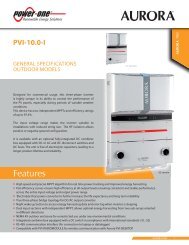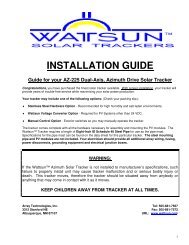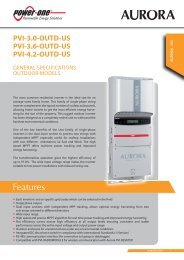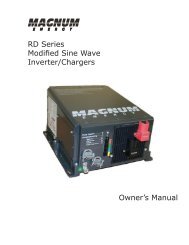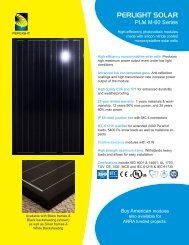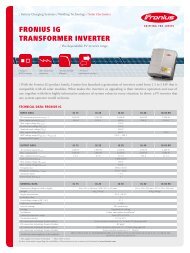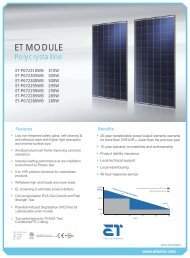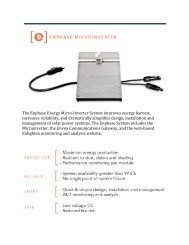MS Series Owner's Manual - Magnum Energy
MS Series Owner's Manual - Magnum Energy
MS Series Owner's Manual - Magnum Energy
You also want an ePaper? Increase the reach of your titles
YUMPU automatically turns print PDFs into web optimized ePapers that Google loves.
Installation<br />
2.1.3 Locating the Inverter<br />
Only install the inverter in a location that meets the following requirements:<br />
Clean and Dry - The inverter should not be installed in an area that allows dust, fumes, insects or<br />
rodents to enter or block the inverter’s ventilation openings. This area also must be free from any<br />
risk of condensation, water or any other liquid that can enter or fall on the inverter. The inverter<br />
uses stainless steel fasteners, plated copper buss-bars, a power-coated aluminum base and the<br />
internal circuit boards are conformal coated all done to help fight the harmful effects of corrosive<br />
environments. However, the inverter’s life is uncertain if used in these type of environments, and<br />
inverter failure under these conditions is not covered under warranty.<br />
Info: If the inverter is installed in an area where moisture may occur, we recommend<br />
putting silicone dielectric grease compound into the electrical ports (items 3 to 6 as<br />
shown in figure 1-1). Before installing the cables or if leaving any ports open, squirt a<br />
liberal amount into each port. Silicone dielectric compound makes an effective moisture<br />
and corrosive barrier to help protect and prevent corrosion to the RJ11 connections.<br />
Cool - The inverter should be protected from direct sun exposure or equipment that produces<br />
extreme heat. The ambient temperature around the inverter must not exceed 77°F (25°C) to<br />
meet power specifications.<br />
Ventilation - In order for the inverter to provide full output power and avoid over temperature<br />
fault conditions; do not cover or block the inverters ventilation openings or install this inverter in<br />
an area with limited airflow. The inverter uses two fans to provide forced air cooling, these fans<br />
pull in air through the intake vents (see item 9 in figure 1-2) and blow out air through the exhaust<br />
vents (see item 13 in figure 1-3). Allow at the minimum, an airspace clearance of 6” at the intake<br />
and exhaust vents and 3” everywhere else to provide adequate ventilation.<br />
If installed in an enclosure, a fresh air intake opening must be provided directly to the front side<br />
(intake vents) of the inverter and an exhaust opening on the back side (exhaust vents) of the<br />
inverter. This allows cool air from the outside to flow into the inverter and heated air to exit the<br />
inverter and out of the enclosure. When mounted in an enclosed compartment, airflow must be ≥<br />
100 cfm in order to maintain no more than a 68°F (20°C) rise in compartment temperature.<br />
CAUTION: Do not mount this inverter in a zero clearance compartment, cover or<br />
obstruct the ventilation openings - overheating may result.<br />
Safe - Keep any flammable/combustible material (i.e., paper, cloth, plastic, etc.) that may be<br />
ignited by heat, sparks or flames at a minimum distance of 2 feet away from the inverter. Do not<br />
install this inverter in any area that contains extremely flammable liquids like gasoline or propane,<br />
or in locations that require ignition-protected devices.<br />
WARNING: The <strong>MS</strong> <strong>Series</strong> inverter/charger is not ignition protected and may not be<br />
located in an engine compartment with gasoline-fueled engines under any circumstance.<br />
Close to the battery bank - As with any inverter, it should be located as close to the batteries as<br />
possible. Long DC wires tend to loose efficiency and reduce the overall performance of an inverter.<br />
However, the unit should not be installed in the same compartment as the batteries or mounted<br />
where it will be exposed to gases produced by the batteries. These gases are corrosive and will<br />
damage the inverter; also if these gases are not ventilated and if allowed to collect, they could ignite<br />
and cause an explosion.<br />
Accessible - Do not block access to the inverter’s remote control and accessory ports as well<br />
as the inverter’s controls and status indicator. Also allow enough room to access the AC and DC<br />
wiring terminals and connections, as they will need to be checked and tighten periodically. See<br />
figure 2-3 for the <strong>MS</strong> <strong>Series</strong> inverter/charger dimensions.<br />
Away from sensitive electronic equipment - High powered inverters can generate levels of RFI<br />
(Radio Frequency Interference). Locate any electronic equipment susceptible to radio frequency<br />
and electromagnetic interference as far away from the inverter as possible.<br />
© 2009 <strong>Magnum</strong> <strong>Energy</strong> Inc.<br />
Page 9




